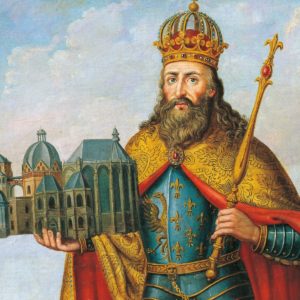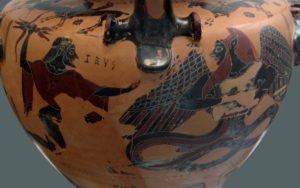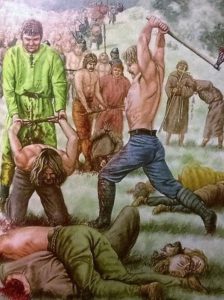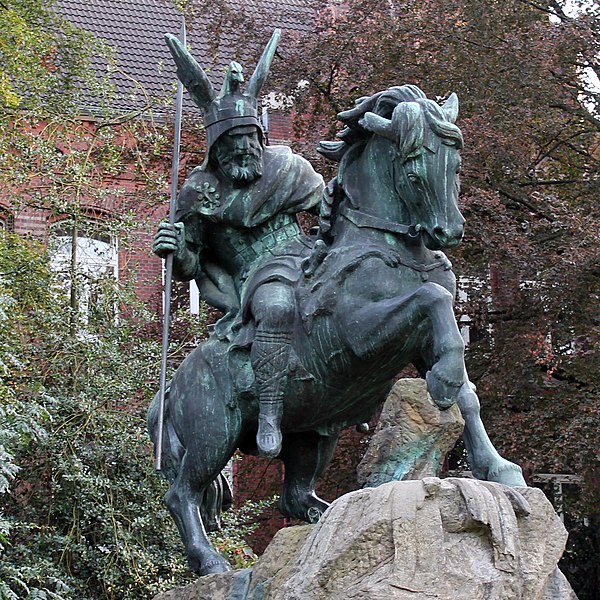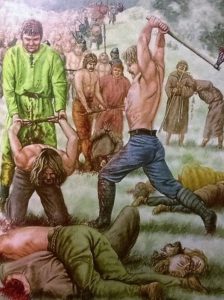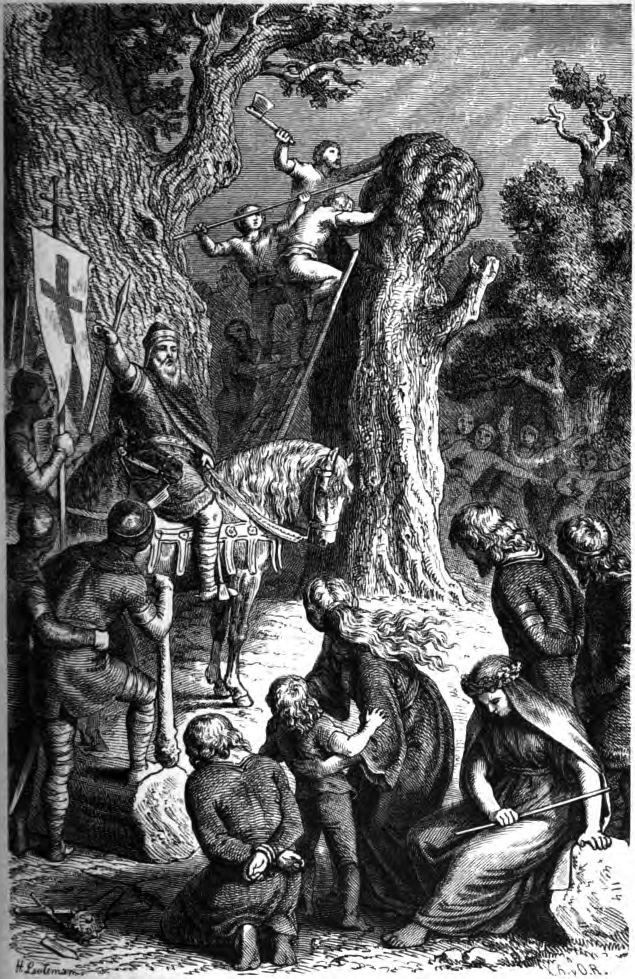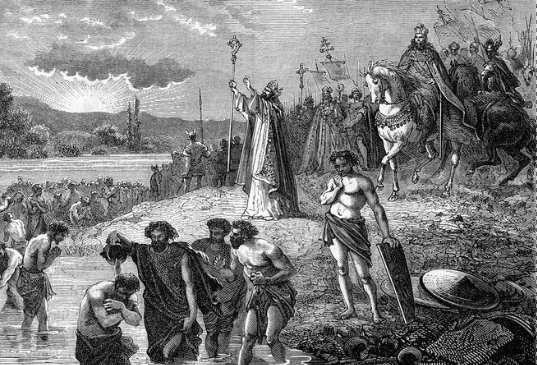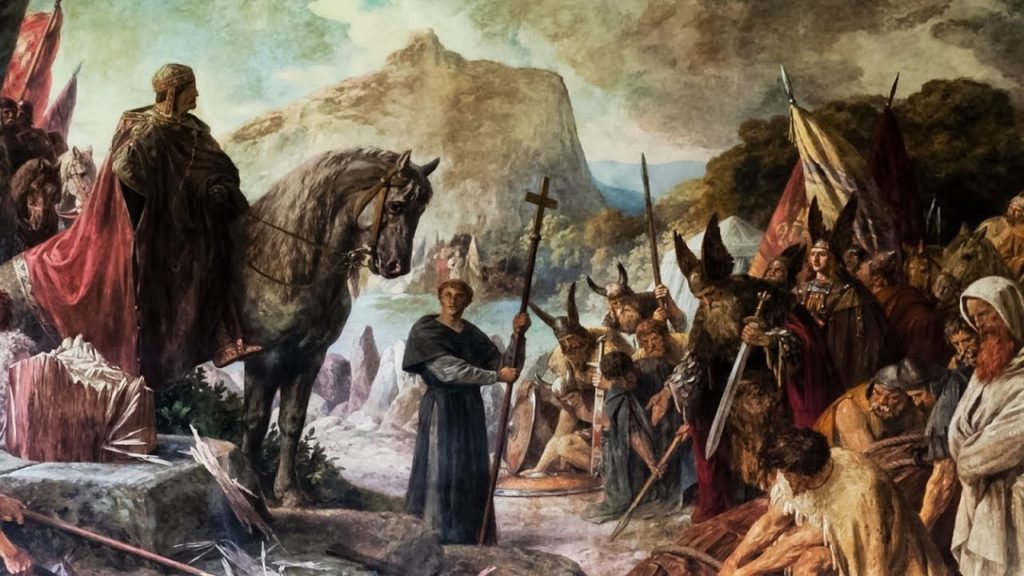Karolus serenissimus augustus a Deo coronatus magnus pacificas (Charles, most serene emperor, great and peaceful emperor, crowned by God). As the beginning of his prolix title already read in 801, that peacemaking Caesar, crowned by God and reigning also per misericordiam Dei (by the mercy of God), the one who from 802 was also called imperator christianissimus and who (supposedly) died with the words of Psalm 31: ‘Into thy hands, O Lord, I commend my spirit’, that man had prepared one slaughter after another, and in his forty-six years of rule—from 768 to 814—he had warred almost continuously with about fifty military campaigns. For only two years (790 and 807) he didn’t fight ‘A happy period for the Church’ (Daniel-Rops).
There is nothing strange about the fact that in the Chanson de geste—the French epic poems of the early Middle Ages—he is already ‘more than two hundred years old’, accompanied by his bravest paladins. He fought against the Lombards, the Frisians, the Bavarians, the Avars, the Slavs, the Basques and the Arabs in Spain, and the Byzantines in southern Italy, with offensive wars almost coldly planned and with which he inflicted death, often cruel and terrible death, on countless people.
And not only did he kill in the wars, but he also had 4,500 prisoners murdered and thousands of families banished. Or, as it is said in one of the oldest liturgical poems in honour of Charles: ‘He struck down thousands, cleansed the earth of the heathen weeds, converted the infidels, broke the statues of the gods, drove out the foreign gods’. For him, according to his biographer Einhard, the wars against the Saxons and the Avars were more important than all other political tasks. Moreover, for certain ecclesiastical circles in the 10th century, the Saxon wars were the most important work he did for the Christian mission.
It is not just that Charles ‘the Great’ in fact killed, subjugated and enslaved without pause (winters generally excepted); that he was nothing but a warrior, conqueror, murderer and predator on the grandest scale—which, as the most learned of scholars have long since taught us, was then so commonplace, so much a part of the ‘Saxon way of life’, was then so commonplace, so much the ‘good’ style of the time, that to criticise it would be a crass anachronism, from our ‘enlightened’ time as well as being arbitrary, rigorist, moralistic and square-jawed in the extreme. No, it is also about the fact that Charles ‘the Great’ carried out all this incredible bloodshed with the most intense participation of Christianity and the Church of his time (which, of course, were also ‘sons of their time’! according to the apologists). And that this Church never protested, but rather took full advantage of it all.
The point is that the Christian feudal state and the Christian feudal Church were one and the same thing—and the same thing in crime.
Charles, whose true ‘book of state’ was the Bible, and whose favourite works included Augustine’s City of God, not only ruled and acted as king of the Franks but also as an enlightened protector of the Church, as an interlocutor and ally of the pope, as evidenced by his legislation, his epistolary correspondence written by ecclesiastics and his closest collaborators. This monarch was a kind of priest-king, he was rector et devotus sanctae ecclesiae defensor et adiutor im omnibus (guide and devoted defender and helper of the Holy Church in all things).
Empire and Church became indissolubly intertwined in the imperium christianum, with hardly any difference between political diets and ecclesiastical councils. Charles convened synods, over which he presided; he chose bishops and abbots as he pleased, and in Saxony he instituted the bishoprics he needed. When he needed an archbishopric for his attacks on the miserly, he had the pope erect the archbishopric of Salzburg. He also disposed of church property, enriching popes and bishops with territories. He granted them numerous privileges of immunity and punished the violation of ecclesiastical immunity with the doubled royal penalty of 600 solids. He freed the bishops from taxes and granted them the right to mint money. He punished the plundering and burning of churches with capital punishment.
But above all, he imposed the universal obligation of tithes on the clergy and demanded tithes for the Episcopal churches at the state level. He also bequeathed three-quarters of his cash to the Church, which he took special care of in his last years (while he left only one-twelfth to his children and grandchildren as a whole, and one-twelfth to the palace servants). And the prelates were also entirely dependent on him, although their influence during his reign—considering him at least all the Frankish bishops as the universal head of the Church—grew considerably: under Charles, they marched to war, acted as judges alongside the counts and were at the head of the royal court.
A 1967 study lists no less than 109 places of worship of St. Charles. These include Aachen (where Charles’ death day, 28 January, is still celebrated in the cathedral today, and where I celebrated my name day as a child), Bremen, Brussels, Dortmund, Frankfurt (one of the main places of Charles’ cult), Fulgem (another of the main places of Charles’ cult), Falkirk (another of the main places of Charles’ cult’), Fulda, Halle, Ingelheim, Cologne, Constance, Lüttich, Mainz, Minden, Münster, Nuremberg, Regensburg, Strasbourg, Trier, Vienna, Würzburg and Zurich. It is also noteworthy that Charles received cultic veneration throughout Saxony. For centuries Charles ‘the Great’, Charlemagne, has been regarded as the ideal model ruler, and for many, for very many, he still is today.
Voltaire and Gibbon stigmatised his barbarism and denied him personal greatness.
At the beginning of the 19th century, Napoleon was exalted to the full extent of his power as a ‘Charlemagne redivivus’. After the founding of the German Reich in the 19th century, Germans rediscovered Charles’ Germanness and his bellicose spirit. In the fascist era, amid the Second World War, the 1200th anniversary of Charlemagne’s birth was celebrated on 2 April 1942, and he was presented as ‘Charles the Unifier’.
The Carolingian empire, the imperiun christianum, as Alcuin called it from 798, the regnum sanctae ecclesiae (Libri Carolini), stretched from the North Sea to the Pyrenees and the Adriatic. It covered what is now France, Belgium, Holland, western Germany, Switzerland, most of Italy, the Marca Hispanica and Corsica. It was approximately 1,200,000 square kilometres in area: almost as large as the Western Roman Empire.
______ 卐 ______
Editor’s Note:
I have been very critical of American white nationalism on this site, but hardly at all of German National Socialism.
It is time to realise that Hitler and the Nazis weren’t perfect. As I implied in my post yesterday, if they had become wise instead of, using chess imagery, gambit the Third Reich against General Winter in Russia, they would have devoted all their efforts to understand the root causes of the dark hour. Karlheinz Deschner, the author of the above text, wouldn’t have hung up his Nazi uniform and become a philo-Semitic liberal because Hitler would have kept his Reich. Deschner could have written his criminal history of Christianity from the point of view of a Germany that had already transvalued its values.
I have said it and it bears repeating: To win the war we must know what we are fighting against. Both the most populist Nazis, like Goebbels, and today’s white nationalists emphasise Jewry. I think Manu Rodriguez, quoted in my post yesterday, was right: the Semitic hydra also includes Christianity and Islam. From time immemorial, anything to do with the Semitic race has been the enemy. Recall that Republican Rome began to decline just after Hannibal and the Carthaginians decimated the flower of the Roman army. That created the spiritual degradation that resulted in the later Roman Empire’s citizens beginning to interbreed with mudbloods. Eventually, the Judeo-Christians took advantage of that opportunity and the rest is history.
After I finish proofreading On Exterminationism, I will start putting together other books-PDFs of the most important entries on this site that show this meta-perspective.
